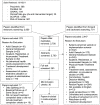Treatment completion among justice-involved youth engaged in behavioral health treatment studies in the United States: A systematic review and meta-analysis
- PMID: 36003208
- PMCID: PMC9389282
- DOI: 10.1017/cts.2022.418
Treatment completion among justice-involved youth engaged in behavioral health treatment studies in the United States: A systematic review and meta-analysis
Abstract
Justice-involved youth (JIY) have high rates of behavioral health disorders, but few can access, much less complete, treatment in the community. Behavioral health treatment completion among JIY is poorly understood, even within treatment studies. Measurement, reporting, and rates of treatment completion vary across studies. This systematic review and meta-analysis synthesizes the literature on rates of treatment completion among JIY enrolled in research studies and identifies potential moderators. After systematically searching 6 electronic databases, data from 13 studies of 20 individual treatment groups were abstracted and coded. A meta-analysis examined individual prevalence estimates of treatment completion in research studies as well as moderator analyses. Prevalence effect sizes revealed high rates of treatment completion (pr = 82.6). However, analysis suggests a high likelihood that publication bias affected the results. Treatment groups that utilized family- or group-based treatment (pr = 87.8) were associated with higher rates of treatment completion compared to treatment groups utilizing individual treatment (pr = 61.1). Findings suggest that it is possible to achieve high rates of treatment completion for JIY, particularly within the context of family- and group-based interventions. However, these findings are limited by concerns about reporting of treatment completion and publication bias.
Keywords: Adolescent; behavioral medicine; juvenile delinquency; meta-analysis; patient participation.
© The Author(s) 2022.
Figures



References
-
- Wasserman GA, McReynolds LS, Schwalbe CS, Keating JM, Jones SA. Psychiatric disorder, comorbidity, and suicidal behavior in juvenile justice youth. Criminal Justice and Behavior 2010; 37(12): 1361–1376.
-
- Henggeler SW, Clingempeel WG, Brondino MJ, Pickrel SG. Four-Year follow-up of multisystemic therapy with substance-abusing and substance-dependent juvenile offenders. Journal of the American Academy of Child & Adolescent Psychiatry 2002; 41(7): 868–874. - PubMed
-
- Kandel DB. Stages and Pathways of Drug Involvement: Examining the Gateway Hypothesis. Cambridge: Cambridge University Press, 2002.
-
- Mutter R, Ali MM, Smith K, Strashny A. Factors associated with substance use treatment completion in residential facilities. Drug and Alcohol Dependence 2015; 154: 291–295. - PubMed
Publication types
LinkOut - more resources
Full Text Sources
Research Materials
